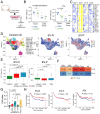Extracellular vesicles from triple negative breast cancer promote pro-inflammatory macrophages associated with better clinical outcome
- PMID: 35439048
- PMCID: PMC9169908
- DOI: 10.1073/pnas.2107394119
Extracellular vesicles from triple negative breast cancer promote pro-inflammatory macrophages associated with better clinical outcome
Abstract
Tumor associated macrophages (TAMs), which differentiate from circulating monocytes, are pervasive across human cancers and comprise heterogeneous populations. The contribution of tumor-derived signals to TAM heterogeneity is not well understood. In particular, tumors release both soluble factors and extracellular vesicles (EVs), whose respective impact on TAM precursors may be different. Here, we show that triple negative breast cancer cells (TNBCs) release EVs and soluble molecules promoting monocyte differentiation toward distinct macrophage fates. EVs specifically promoted proinflammatory macrophages bearing an interferon response signature. The combination in TNBC EVs of surface CSF-1 promoting survival and cargoes promoting cGAS/STING or other activation pathways led to differentiation of this particular macrophage subset. Notably, macrophages expressing the EV-induced signature were found among patients’ TAMs. Furthermore, higher expression of this signature was associated with T cell infiltration and extended patient survival. Together, this data indicates that TNBC-released CSF-1-bearing EVs promote a tumor immune microenvironment associated with a better prognosis in TNBC patients.
Keywords: CSF-1; exosomes; extracellular vesicles; macrophages; triple-negative breast cancer.
Conflict of interest statement
The authors declare no competing interest.
Figures






References
-
- Cassetta L., Pollard J. W., Targeting macrophages: Therapeutic approaches in cancer. Nat. Rev. Drug Discov. 17, 887–904 (2018). - PubMed
Publication types
MeSH terms
Grants and funding
LinkOut - more resources
Full Text Sources
Other Literature Sources
Molecular Biology Databases
Research Materials
Miscellaneous

